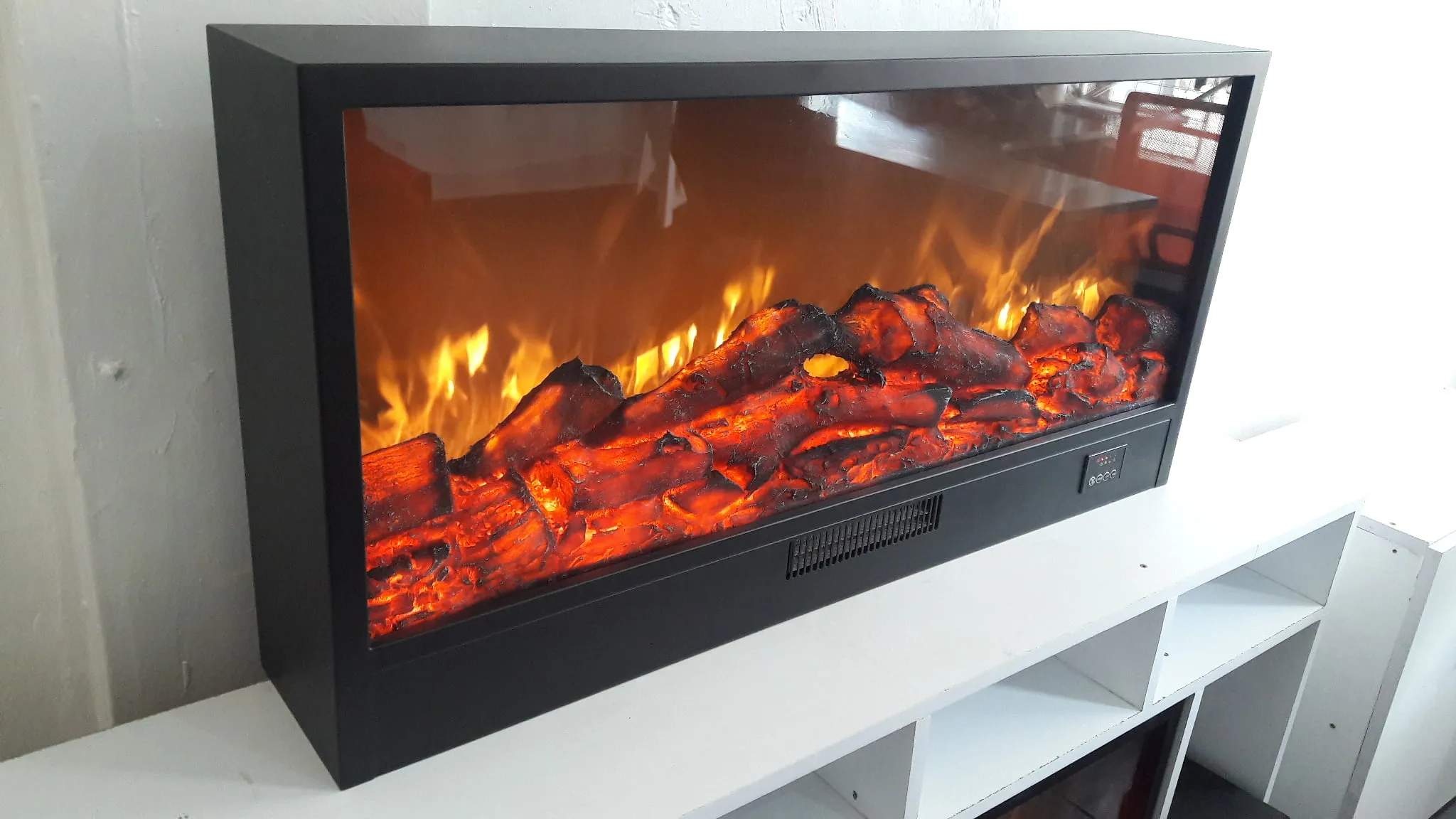
Best Wood Stove for Small Cabin - Reviews & Buying Guide

Are you dreaming of cozying up in your small cabin with a warm and inviting wood burning stove? Look no further! We’ve scoured the market to bring you the top 10 wood burning stoves for small cabins.
From heating efficiency to size and price, we’ve considered all the important factors to help you find the perfect fit for your cabin. So grab a cup of cocoa, get comfortable, and let us guide you through the best wood burning stoves for your snug little retreat.
Here are the 10 best wood burning stoves for small cabins:
-
US Stove Company Small Wood Stove
-
Drolet Escape 1500 Wood Stove
-
England’s Stove Works Survivor Wood Stove
-
Napoleon 1100CP Wood Stove
-
Osburn 9000 Wood Stove
-
Quadra-Fire Santa Fe Wood Stove
-
Timberwolf Economizer Wood Stove
-
Vogelzang Colonial Wood Stove
-
Ashley Hearth Products AW2520E-P Wood Stove
-
Pacific Energy Vista Wood Stove
Benefits of Using a Wood Burning Stove in a Small Cabin
A wood burning stove is a practical and efficient heating option for a small cabin. Not only does it provide warmth and comfort during the colder months, but it also adds a cozy and rustic touch to the atmosphere of the cabin. In this guide, we will explore the many benefits of using a wood burning stove in a small cabin, as well as some tips for maintaining and using the stove safely and effectively.
Benefits of using a wood burning stove in a small cabin:
-
Cost-effective heating: One of the main benefits of using a wood burning stove in a small cabin is that it can provide cost-effective heating. Wood is often more affordable than other heating fuels, and if you have access to a source of free firewood, it can be a very budget-friendly option.
-
Energy independence: Another advantage of using a wood burning stove is that it allows you to be more energy independent. If you live in a remote location or are off-grid, a wood burning stove can provide a reliable source of heat without relying on electricity or natural gas.
-
Ambiance and atmosphere: A wood burning stove adds a sense of rustic charm and cozy ambiance to a small cabin. The sight and sound of the flames, as well as the warmth it provides, can create a welcoming and inviting atmosphere.
-
Health benefits: In addition to providing warmth, a wood burning stove can also have health benefits. The heat from the stove can help to improve air circulation and reduce humidity, which can help to prevent the growth of mold and other allergens.
-
Emergency preparedness: In the event of a power outage or other emergency situation, a wood burning stove can provide a vital source of heat and warmth.
Tips for maintaining and using a wood burning stove safely and effectively:
-
Follow the manufacturer’s instructions for installation and use. It is important to properly install and use the stove to ensure its safety and effectiveness.
-
Use only dry, seasoned firewood. Wet or green wood is more difficult to ignite and burns less efficiently.
-
Don’t over-fire the stove. It is important to maintain a consistent and moderate fire in the stove to ensure that it is operating safely and efficiently.
-
Keep the stove and chimney clean. Regularly cleaning the stove and chimney can help to prevent the build-up of creosote, which can cause a fire hazard.
-
Use a stove thermometer. A stove thermometer can help you to monitor the temperature of the stove and ensure that it is operating within a safe range.
There are two types of wood burning stoves: catalytic combustor and noncatalytic.
Catalytic Combustor Stoves (cats):
-
Catalytic Combustor Stoves burn wood with a slower, longer, and more controlled combustion temperature of 600 degrees Fahrenheit.
-
Cats should have a main body thickness of a minimum of 1/4-inch plate steel or cast iron. Its bypass plate should be at least 5/16-inch thick and grip a piece of thin paper tightly when closed.
-
Cats need little upkeep; any ash that collects on the combustor may be cleaned gently with a soft brush.
-
Some signs of needed combustor replacement are creosote build-up, excessive chimney smoke, and a general sluggish stove operation.
Noncatalytic Combustor Stoves (“noncats”):
-
Noncats burn wood within a heavily insulated firebox that ensures a more thorough combustion.
-
Noncatalytic stoves do not require the level of care as catalytic stoves.
-
Noncats should be constructed with a minimum of 1/4-inch cast iron or plate steel. The baffles, located in the interior roof, should be a minimum of 5/16-inch plate steel and have v-shaped support beams.
Helpful Tips:
-
When choosing a wood stove, it is important to know your specific heating space needs. It is crucial to place the wood stove with safe clearances. Each model will have its own precise requirements, as well as instructions regarding installation. As a wise safety precaution, have your stove installed professionally.
-
Purchasing the very best stove you can afford is economical over the long haul, higher efficiency levels will help to pay back your initial investment.
-
Be aware of the fuel limitations of your stove. Most wood stoves are meant to burn wood only.
-
Avoid burning green (unseasoned) wood which may contain up to 50% of its weight in moisture and needs to be burned off before the heat can reach your house.
-
Build small, hot fires for maximum burning of volatile gases and for fewer air quality and safety problems.
-
Keep the stove’s air-intake vents clear by removing excess ashes.
-
Observe the amount of smoke coming from your chimney. The less smoke, the cleaner the burning process.
-
Wood stoves and chimneys should be inspected at least once each year by a stove dealer or chimney sweep.
How To Choose, Use And Buy A Wood Burning Cook Stove

Choosing a wood burning cook stove is a major decision for most people. This is because it demands quite a level of commitment and effort that people are generally just not used to. Yet the wood heat and cooking are incomparable.
The typical thermostatically controlled gas or electric cook stove is so reliable and easy to use that there must be a good reason to want to cook with wood. Perhaps it is because of a desire to be off the grid, or self-sufficient, or maybe just a desire to return to the memories of bygone eras.
Still, a wood burning cook stove can be a highly efficient and wonderful appliance to own.
What to look for in a wood burning cook stove
There are several things to look for in choosing a wood burning cook stove. First, consider the size. How much do you intend to actually cook with your stove? How many people will be eating all those yummy meals and loaves of bread?
Consider also your heating demands. A good wood burning cook stove can also double as a heat source for at least one level of most homes, and this means you need an additional source of heat. You also should consider a backup source during the summer months, as you most certainly don’t want to be heating your house in the heat of July!
One thing to think about when choosing a cook stove is the level of quality you need. If you only want to cook meals on the stovetop, almost any good stove will do. However, if you are looking to bake or use the oven for meals, you should definitely look into a full-blown cookstove.
Choosing a wood burning cook stove
Quality wood burning cook stoves are expensive. A Waterford Stanley Wood Cookstove can cost you over $5,000 new. If you are lucky enough to find a good used one you could save some money. These stoves are made in Waterford, Ireland, where they have been in use for over 100 years.
An Elmira Stove Works Fireview Cookstove is a high efficiency, an air-tight stove that has a great reputation. They come with a water jacket and can quite easily heat a good portion of your house. These cost around $4,200 and up, depending on the size and features.
The Baker’s Oven is a clever adaptation of a cookstove and a heating wood stove. You get the best of both worlds at a reasonable price. These Australian stoves can heat your home, cook your bread and heat up your soup on the top, all at once! The start around $2,500.
All in all, cooking with wood is wonderful and the food is incredible. You can heat your house, warm your food, incubate yogurt, bake bread and humidify your house. However, it all comes with the effort you put into it.
Don’t forget the wood cutting, splitting, stacking hauling, ashes, cold mornings, slow heat up times and so on. The romantics can quickly fade for the faint of heart or those who do not have the time.
How To Buy A Used Wood Stove—Cast Iron Or Heavy Gage Steel
Knowing how to buy a used wood stove is essential to get the best-cast iron or steel wood stove for your money, and it requires some knowledge and understanding. If you just go by price, or what the seller tells you, you may be quite disappointed.
How to buy a used wood stove—considerations
-
Price range of your used wood stove
-
Purpose—what will you be heating?
-
Size requirements—based on what you will be heating
-
Cast iron or heavy gage steel?
-
Wood supply—type of wood, price of firewood, storage space, etc.
Used wood stove price range
Once you do know your price range, the options are more clearly defined. You can spend anywhere from hundreds to thousands of dollars on a good used wood stove, so it is important to know what you are looking for. Price is not the only issue, but is obviously important.
Purpose for you used wood stove
You must determine what you want the stove for. A hunting camp stove is one matter, a fireplace wood stove is another, and heating your new home is yet another. You may be looking for a good cast iron wood stove, or a pellet stove insert, all require special knowledge.
How big of wood stove do you really need?
Finding the right size stove is critical to having a successful heating experience. If your Fisher wood stove heats you out of the house, you are not going to be happy. On the other hand, you may buy a used Jotul cast iron wood stove that is just too small for you needs, you will not be happy with this either.
First determine the cubic feet you are going to heat and compare this with the wood stove specifications provided by the manufacturer. Also consider the type of wood you will be burning, as dry hardwood will certainly heat a larger area than lower quality wood.
Type of used wood stove—cast iron or heavy gauge steel
Should you buy a cast iron or heavy gage steel used wood stove? This depends entirely on your personal preference and budget. Most people consider cast iron superior to steel, but steel works well in many stoves.
Then there are the newer pellet wood stoves that many people find very efficient and easy to use. They are very low maintenance and require little storage for the wood.
Cast iron tends to take longer to heat up, and longer to cool off. Steel heats up very quickly and will take the chill off a room faster than cast iron. Cast iron generally lasts longer and is not likely to warp, while the heavy gage steel is likely to discolor and warp. The heavier the stove, the better it is, generally.
Quality cast iron wood stove manufacturers
Some cast iron makers include Jotul, Vermont Castings, Morso, Hampton, and The Woodstock Soapstone Company. All of these stoves are beautiful and highly efficient.
Quality steel wood stove stove companies
High quality steel stove makers include Lopi, Vogelzang, Enviro, and Ashley. Many of these stoves are excellent buys and are made to high quality standards to last for many years.
How to find a deal on a used wood stove
A very good way to prepare and educate yourself is to visit a showroom and check out the different models. You can also do this online, but there is no substitute for actually touching and seeing one. Ask a lot of questions from knowledgeable salesmen and friends.
The reputation of a stove means a lot, especially if it has been in production for many years. The European stoves have stood the test of many generations, plus they have very strict emission guidelines to adhere to.
The last used cast iron wood stove I bought was a Jotul Black Bear. I found it in the local Bargain News and paid $850. The receipt showed the owner had paid much more, and only used it for two seasons. I love this thing and have no complaints whatsoever.
Check out hardware store bulletin boards, Craigs List, your local newpaper, word of mouth, a wood stove store, and Ebay.